Human Resource Management Report: NatWest Bank Case Study Analysis
VerifiedAdded on 2021/02/19
|12
|3648
|24
Report
AI Summary
This report provides a comprehensive analysis of Human Resource Management (HRM) practices at NatWest Bank. It begins with an introduction to HRM, its purpose, and functions, specifically in the context of workforce planning and resourcing. The report then explores different approaches to recruitment and selection, evaluating their strengths and weaknesses. It delves into the benefits of various HRM practices for both employers and employees, along with an assessment of their effectiveness on organizational profit and productivity. The importance of employee relations in influencing HRM decision-making is examined, alongside the key elements of employment legislation and their impact on HRM. The report concludes by applying HRM practices in a work-related context, offering a holistic view of how NatWest Bank manages its human resources to achieve its business objectives. The report is a case study to explore the real-world application of HRM principles.
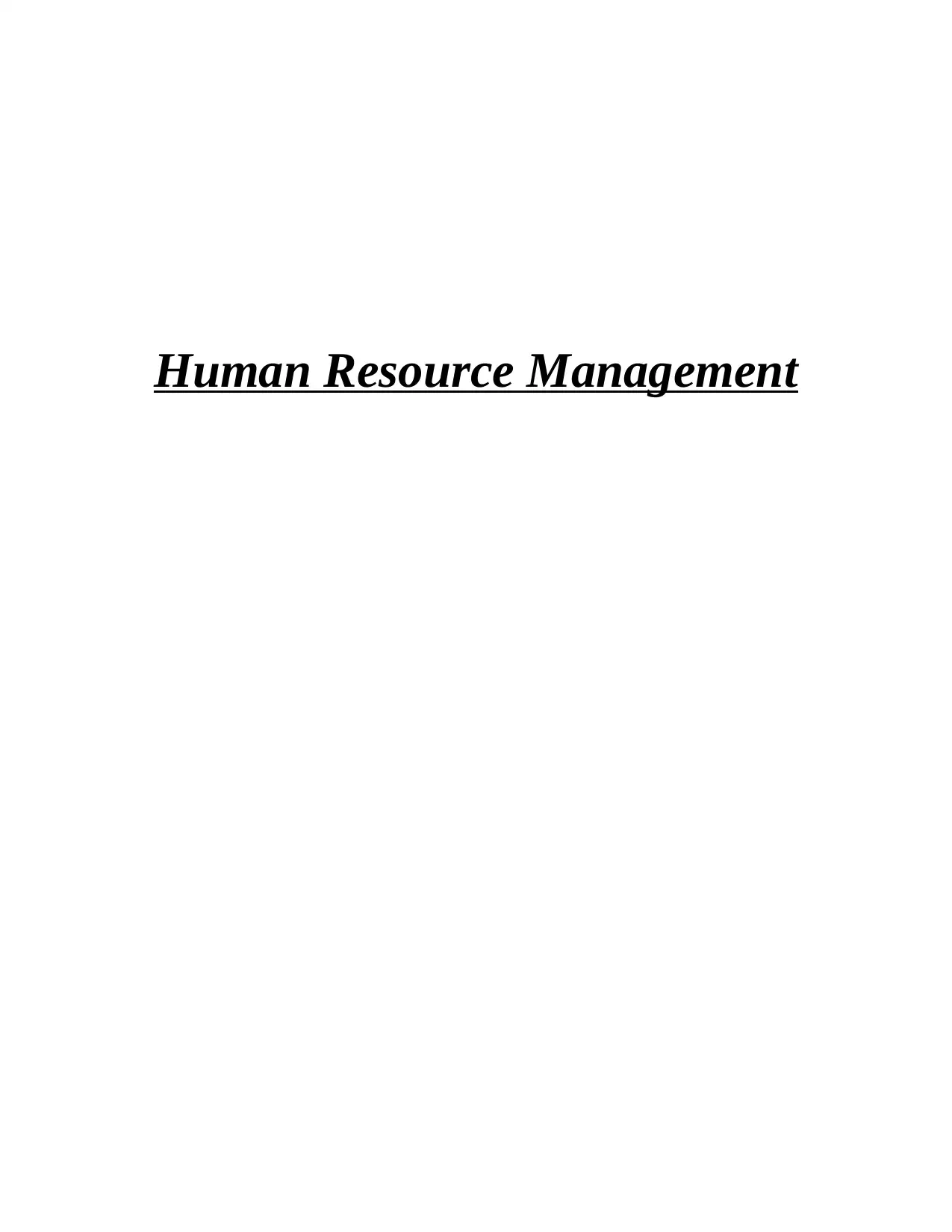
Human Resource Management
Paraphrase This Document
Need a fresh take? Get an instant paraphrase of this document with our AI Paraphraser
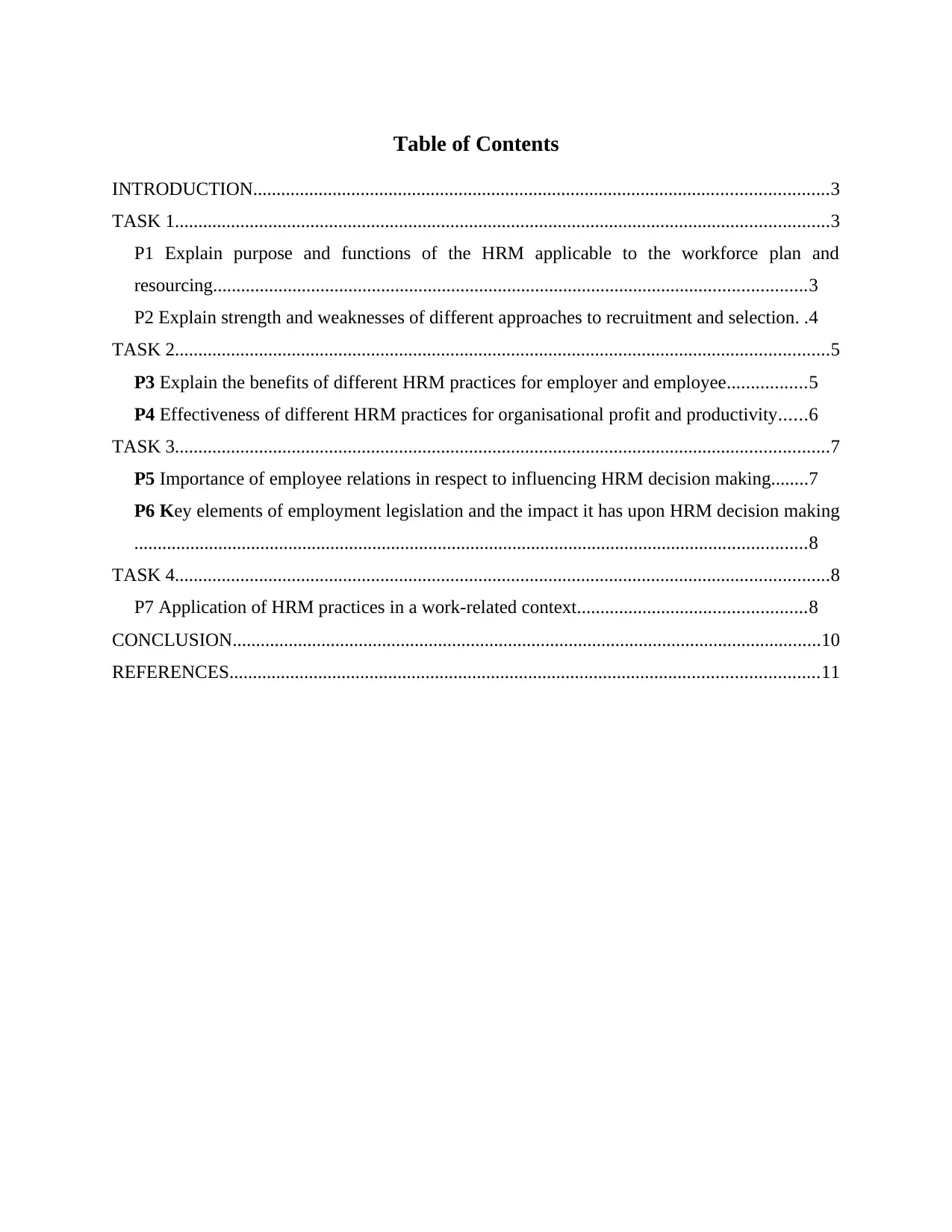
Table of Contents
INTRODUCTION...........................................................................................................................3
TASK 1............................................................................................................................................3
P1 Explain purpose and functions of the HRM applicable to the workforce plan and
resourcing...............................................................................................................................3
P2 Explain strength and weaknesses of different approaches to recruitment and selection. .4
TASK 2............................................................................................................................................5
P3 Explain the benefits of different HRM practices for employer and employee.................5
P4 Effectiveness of different HRM practices for organisational profit and productivity......6
TASK 3............................................................................................................................................7
P5 Importance of employee relations in respect to influencing HRM decision making........7
P6 Key elements of employment legislation and the impact it has upon HRM decision making
................................................................................................................................................8
TASK 4............................................................................................................................................8
P7 Application of HRM practices in a work-related context.................................................8
CONCLUSION..............................................................................................................................10
REFERENCES..............................................................................................................................11
INTRODUCTION...........................................................................................................................3
TASK 1............................................................................................................................................3
P1 Explain purpose and functions of the HRM applicable to the workforce plan and
resourcing...............................................................................................................................3
P2 Explain strength and weaknesses of different approaches to recruitment and selection. .4
TASK 2............................................................................................................................................5
P3 Explain the benefits of different HRM practices for employer and employee.................5
P4 Effectiveness of different HRM practices for organisational profit and productivity......6
TASK 3............................................................................................................................................7
P5 Importance of employee relations in respect to influencing HRM decision making........7
P6 Key elements of employment legislation and the impact it has upon HRM decision making
................................................................................................................................................8
TASK 4............................................................................................................................................8
P7 Application of HRM practices in a work-related context.................................................8
CONCLUSION..............................................................................................................................10
REFERENCES..............................................................................................................................11
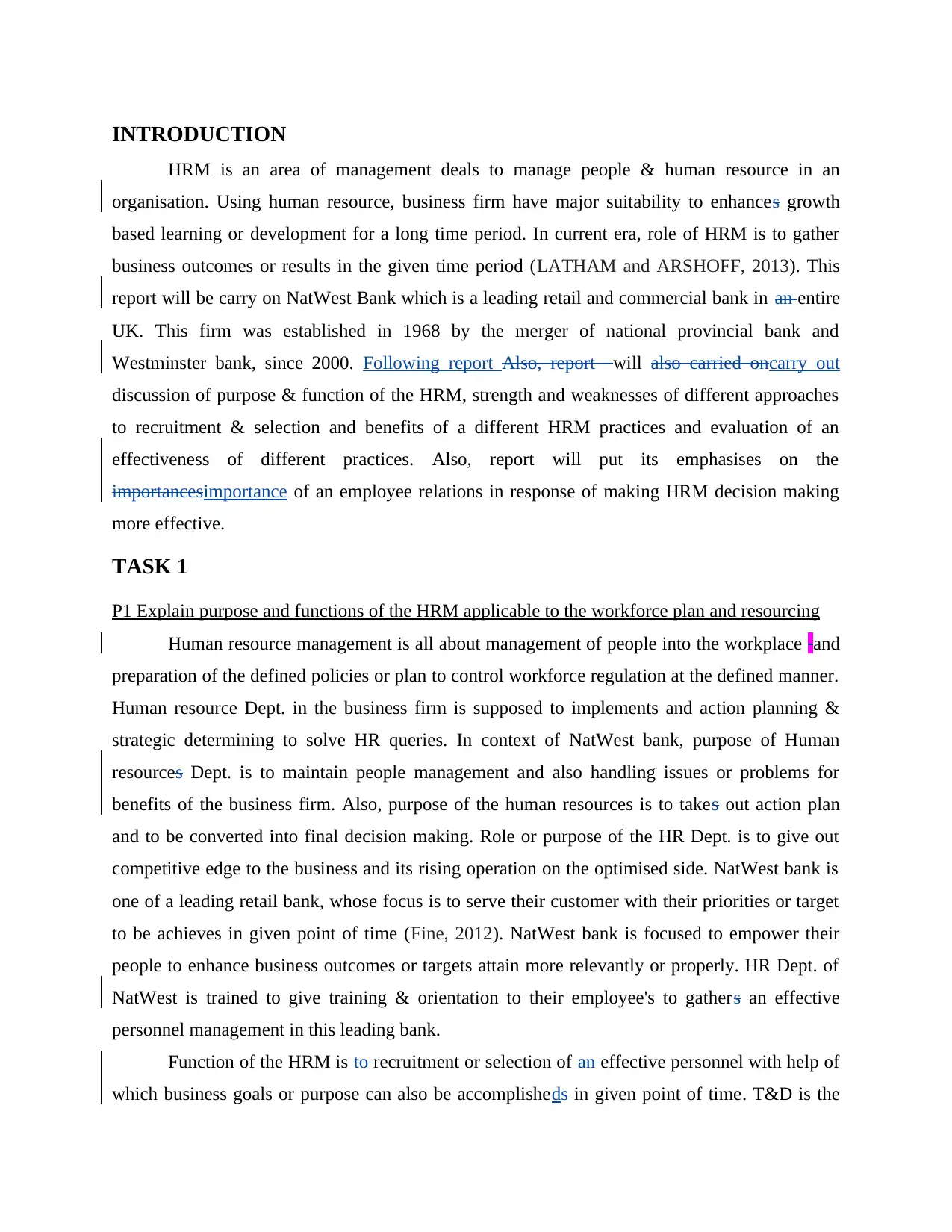
INTRODUCTION
HRM is an area of management deals to manage people & human resource in an
organisation. Using human resource, business firm have major suitability to enhances growth
based learning or development for a long time period. In current era, role of HRM is to gather
business outcomes or results in the given time period (LATHAM and ARSHOFF, 2013). This
report will be carry on NatWest Bank which is a leading retail and commercial bank in an entire
UK. This firm was established in 1968 by the merger of national provincial bank and
Westminster bank, since 2000. Following report Also, report will also carried oncarry out
discussion of purpose & function of the HRM, strength and weaknesses of different approaches
to recruitment & selection and benefits of a different HRM practices and evaluation of an
effectiveness of different practices. Also, report will put its emphasises on the
importancesimportance of an employee relations in response of making HRM decision making
more effective.
TASK 1
P1 Explain purpose and functions of the HRM applicable to the workforce plan and resourcing
Human resource management is all about management of people into the workplace and
preparation of the defined policies or plan to control workforce regulation at the defined manner.
Human resource Dept. in the business firm is supposed to implements and action planning &
strategic determining to solve HR queries. In context of NatWest bank, purpose of Human
resources Dept. is to maintain people management and also handling issues or problems for
benefits of the business firm. Also, purpose of the human resources is to takes out action plan
and to be converted into final decision making. Role or purpose of the HR Dept. is to give out
competitive edge to the business and its rising operation on the optimised side. NatWest bank is
one of a leading retail bank, whose focus is to serve their customer with their priorities or target
to be achieves in given point of time (Fine, 2012). NatWest bank is focused to empower their
people to enhance business outcomes or targets attain more relevantly or properly. HR Dept. of
NatWest is trained to give training & orientation to their employee's to gathers an effective
personnel management in this leading bank.
Function of the HRM is to recruitment or selection of an effective personnel with help of
which business goals or purpose can also be accomplisheds in given point of time. T&D is the
HRM is an area of management deals to manage people & human resource in an
organisation. Using human resource, business firm have major suitability to enhances growth
based learning or development for a long time period. In current era, role of HRM is to gather
business outcomes or results in the given time period (LATHAM and ARSHOFF, 2013). This
report will be carry on NatWest Bank which is a leading retail and commercial bank in an entire
UK. This firm was established in 1968 by the merger of national provincial bank and
Westminster bank, since 2000. Following report Also, report will also carried oncarry out
discussion of purpose & function of the HRM, strength and weaknesses of different approaches
to recruitment & selection and benefits of a different HRM practices and evaluation of an
effectiveness of different practices. Also, report will put its emphasises on the
importancesimportance of an employee relations in response of making HRM decision making
more effective.
TASK 1
P1 Explain purpose and functions of the HRM applicable to the workforce plan and resourcing
Human resource management is all about management of people into the workplace and
preparation of the defined policies or plan to control workforce regulation at the defined manner.
Human resource Dept. in the business firm is supposed to implements and action planning &
strategic determining to solve HR queries. In context of NatWest bank, purpose of Human
resources Dept. is to maintain people management and also handling issues or problems for
benefits of the business firm. Also, purpose of the human resources is to takes out action plan
and to be converted into final decision making. Role or purpose of the HR Dept. is to give out
competitive edge to the business and its rising operation on the optimised side. NatWest bank is
one of a leading retail bank, whose focus is to serve their customer with their priorities or target
to be achieves in given point of time (Fine, 2012). NatWest bank is focused to empower their
people to enhance business outcomes or targets attain more relevantly or properly. HR Dept. of
NatWest is trained to give training & orientation to their employee's to gathers an effective
personnel management in this leading bank.
Function of the HRM is to recruitment or selection of an effective personnel with help of
which business goals or purpose can also be accomplisheds in given point of time. T&D is the
⊘ This is a preview!⊘
Do you want full access?
Subscribe today to unlock all pages.

Trusted by 1+ million students worldwide
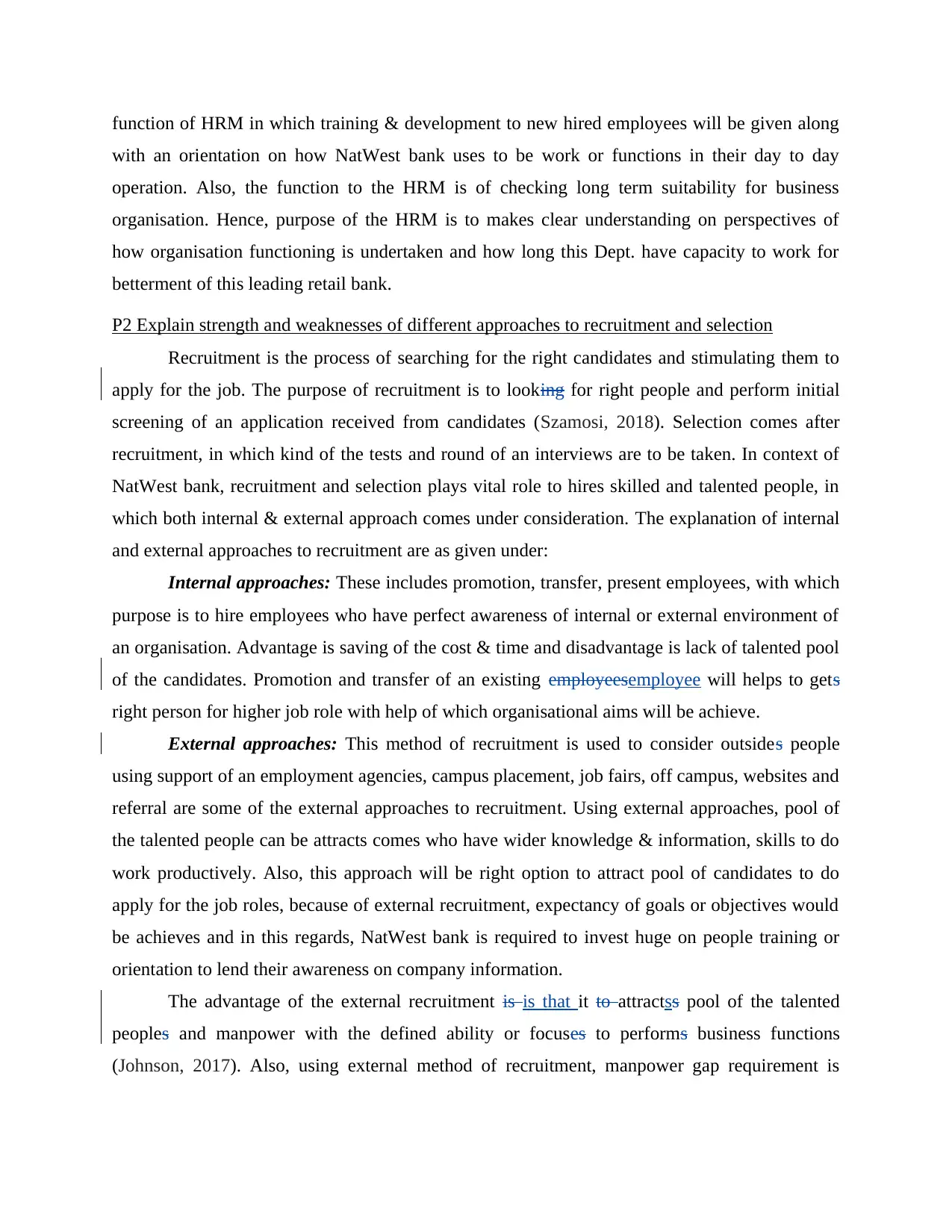
function of HRM in which training & development to new hired employees will be given along
with an orientation on how NatWest bank uses to be work or functions in their day to day
operation. Also, the function to the HRM is of checking long term suitability for business
organisation. Hence, purpose of the HRM is to makes clear understanding on perspectives of
how organisation functioning is undertaken and how long this Dept. have capacity to work for
betterment of this leading retail bank.
P2 Explain strength and weaknesses of different approaches to recruitment and selection
Recruitment is the process of searching for the right candidates and stimulating them to
apply for the job. The purpose of recruitment is to looking for right people and perform initial
screening of an application received from candidates (Szamosi, 2018). Selection comes after
recruitment, in which kind of the tests and round of an interviews are to be taken. In context of
NatWest bank, recruitment and selection plays vital role to hires skilled and talented people, in
which both internal & external approach comes under consideration. The explanation of internal
and external approaches to recruitment are as given under:
Internal approaches: These includes promotion, transfer, present employees, with which
purpose is to hire employees who have perfect awareness of internal or external environment of
an organisation. Advantage is saving of the cost & time and disadvantage is lack of talented pool
of the candidates. Promotion and transfer of an existing employeesemployee will helps to gets
right person for higher job role with help of which organisational aims will be achieve.
External approaches: This method of recruitment is used to consider outsides people
using support of an employment agencies, campus placement, job fairs, off campus, websites and
referral are some of the external approaches to recruitment. Using external approaches, pool of
the talented people can be attracts comes who have wider knowledge & information, skills to do
work productively. Also, this approach will be right option to attract pool of candidates to do
apply for the job roles, because of external recruitment, expectancy of goals or objectives would
be achieves and in this regards, NatWest bank is required to invest huge on people training or
orientation to lend their awareness on company information.
The advantage of the external recruitment is is that it to attractss pool of the talented
peoples and manpower with the defined ability or focuses to performs business functions
(Johnson, 2017). Also, using external method of recruitment, manpower gap requirement is
with an orientation on how NatWest bank uses to be work or functions in their day to day
operation. Also, the function to the HRM is of checking long term suitability for business
organisation. Hence, purpose of the HRM is to makes clear understanding on perspectives of
how organisation functioning is undertaken and how long this Dept. have capacity to work for
betterment of this leading retail bank.
P2 Explain strength and weaknesses of different approaches to recruitment and selection
Recruitment is the process of searching for the right candidates and stimulating them to
apply for the job. The purpose of recruitment is to looking for right people and perform initial
screening of an application received from candidates (Szamosi, 2018). Selection comes after
recruitment, in which kind of the tests and round of an interviews are to be taken. In context of
NatWest bank, recruitment and selection plays vital role to hires skilled and talented people, in
which both internal & external approach comes under consideration. The explanation of internal
and external approaches to recruitment are as given under:
Internal approaches: These includes promotion, transfer, present employees, with which
purpose is to hire employees who have perfect awareness of internal or external environment of
an organisation. Advantage is saving of the cost & time and disadvantage is lack of talented pool
of the candidates. Promotion and transfer of an existing employeesemployee will helps to gets
right person for higher job role with help of which organisational aims will be achieve.
External approaches: This method of recruitment is used to consider outsides people
using support of an employment agencies, campus placement, job fairs, off campus, websites and
referral are some of the external approaches to recruitment. Using external approaches, pool of
the talented people can be attracts comes who have wider knowledge & information, skills to do
work productively. Also, this approach will be right option to attract pool of candidates to do
apply for the job roles, because of external recruitment, expectancy of goals or objectives would
be achieves and in this regards, NatWest bank is required to invest huge on people training or
orientation to lend their awareness on company information.
The advantage of the external recruitment is is that it to attractss pool of the talented
peoples and manpower with the defined ability or focuses to performs business functions
(Johnson, 2017). Also, using external method of recruitment, manpower gap requirement is
Paraphrase This Document
Need a fresh take? Get an instant paraphrase of this document with our AI Paraphraser
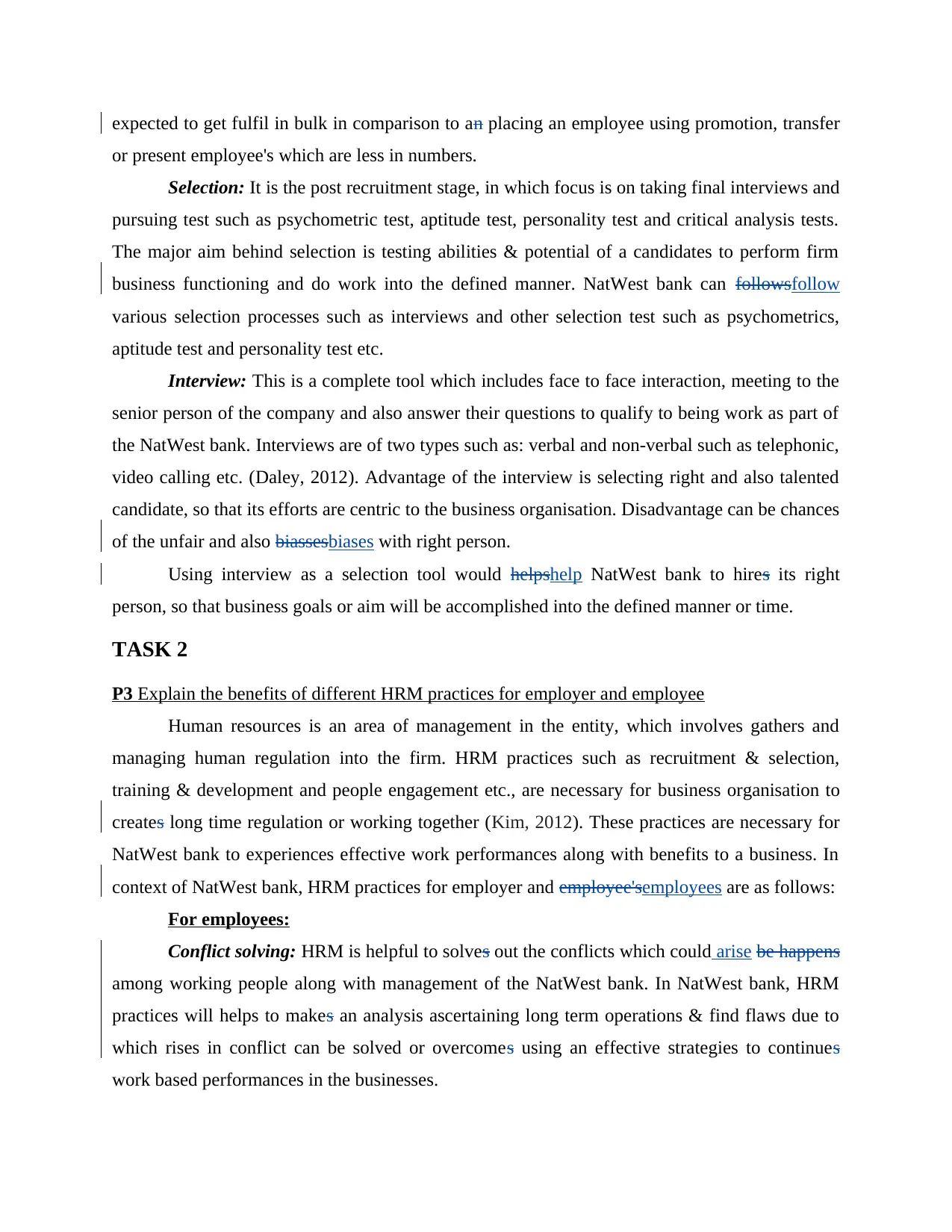
expected to get fulfil in bulk in comparison to an placing an employee using promotion, transfer
or present employee's which are less in numbers.
Selection: It is the post recruitment stage, in which focus is on taking final interviews and
pursuing test such as psychometric test, aptitude test, personality test and critical analysis tests.
The major aim behind selection is testing abilities & potential of a candidates to perform firm
business functioning and do work into the defined manner. NatWest bank can followsfollow
various selection processes such as interviews and other selection test such as psychometrics,
aptitude test and personality test etc.
Interview: This is a complete tool which includes face to face interaction, meeting to the
senior person of the company and also answer their questions to qualify to being work as part of
the NatWest bank. Interviews are of two types such as: verbal and non-verbal such as telephonic,
video calling etc. (Daley, 2012). Advantage of the interview is selecting right and also talented
candidate, so that its efforts are centric to the business organisation. Disadvantage can be chances
of the unfair and also biassesbiases with right person.
Using interview as a selection tool would helpshelp NatWest bank to hires its right
person, so that business goals or aim will be accomplished into the defined manner or time.
TASK 2
P3 Explain the benefits of different HRM practices for employer and employee
Human resources is an area of management in the entity, which involves gathers and
managing human regulation into the firm. HRM practices such as recruitment & selection,
training & development and people engagement etc., are necessary for business organisation to
creates long time regulation or working together (Kim, 2012). These practices are necessary for
NatWest bank to experiences effective work performances along with benefits to a business. In
context of NatWest bank, HRM practices for employer and employee'semployees are as follows:
For employees:
Conflict solving: HRM is helpful to solves out the conflicts which could arise be happens
among working people along with management of the NatWest bank. In NatWest bank, HRM
practices will helps to makes an analysis ascertaining long term operations & find flaws due to
which rises in conflict can be solved or overcomes using an effective strategies to continues
work based performances in the businesses.
or present employee's which are less in numbers.
Selection: It is the post recruitment stage, in which focus is on taking final interviews and
pursuing test such as psychometric test, aptitude test, personality test and critical analysis tests.
The major aim behind selection is testing abilities & potential of a candidates to perform firm
business functioning and do work into the defined manner. NatWest bank can followsfollow
various selection processes such as interviews and other selection test such as psychometrics,
aptitude test and personality test etc.
Interview: This is a complete tool which includes face to face interaction, meeting to the
senior person of the company and also answer their questions to qualify to being work as part of
the NatWest bank. Interviews are of two types such as: verbal and non-verbal such as telephonic,
video calling etc. (Daley, 2012). Advantage of the interview is selecting right and also talented
candidate, so that its efforts are centric to the business organisation. Disadvantage can be chances
of the unfair and also biassesbiases with right person.
Using interview as a selection tool would helpshelp NatWest bank to hires its right
person, so that business goals or aim will be accomplished into the defined manner or time.
TASK 2
P3 Explain the benefits of different HRM practices for employer and employee
Human resources is an area of management in the entity, which involves gathers and
managing human regulation into the firm. HRM practices such as recruitment & selection,
training & development and people engagement etc., are necessary for business organisation to
creates long time regulation or working together (Kim, 2012). These practices are necessary for
NatWest bank to experiences effective work performances along with benefits to a business. In
context of NatWest bank, HRM practices for employer and employee'semployees are as follows:
For employees:
Conflict solving: HRM is helpful to solves out the conflicts which could arise be happens
among working people along with management of the NatWest bank. In NatWest bank, HRM
practices will helps to makes an analysis ascertaining long term operations & find flaws due to
which rises in conflict can be solved or overcomes using an effective strategies to continues
work based performances in the businesses.
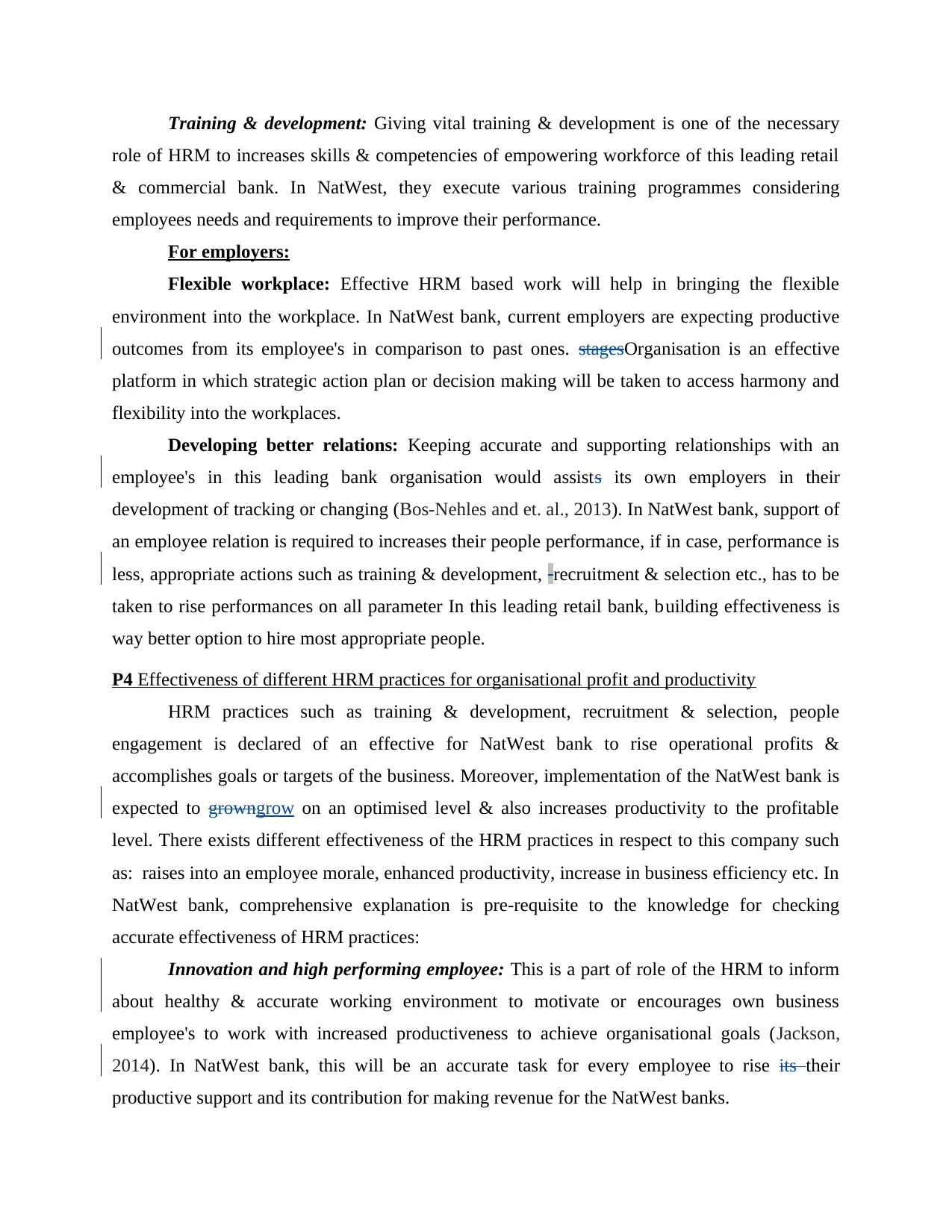
Training & development: Giving vital training & development is one of the necessary
role of HRM to increases skills & competencies of empowering workforce of this leading retail
& commercial bank. In NatWest, they execute various training programmes considering
employees needs and requirements to improve their performance.
For employers:
Flexible workplace: Effective HRM based work will help in bringing the flexible
environment into the workplace. In NatWest bank, current employers are expecting productive
outcomes from its employee's in comparison to past ones. stagesOrganisation is an effective
platform in which strategic action plan or decision making will be taken to access harmony and
flexibility into the workplaces.
Developing better relations: Keeping accurate and supporting relationships with an
employee's in this leading bank organisation would assists its own employers in their
development of tracking or changing (Bos‐Nehles and et. al., 2013). In NatWest bank, support of
an employee relation is required to increases their people performance, if in case, performance is
less, appropriate actions such as training & development, recruitment & selection etc., has to be
taken to rise performances on all parameter In this leading retail bank, building effectiveness is
way better option to hire most appropriate people.
P4 Effectiveness of different HRM practices for organisational profit and productivity
HRM practices such as training & development, recruitment & selection, people
engagement is declared of an effective for NatWest bank to rise operational profits &
accomplishes goals or targets of the business. Moreover, implementation of the NatWest bank is
expected to growngrow on an optimised level & also increases productivity to the profitable
level. There exists different effectiveness of the HRM practices in respect to this company such
as: raises into an employee morale, enhanced productivity, increase in business efficiency etc. In
NatWest bank, comprehensive explanation is pre-requisite to the knowledge for checking
accurate effectiveness of HRM practices:
Innovation and high performing employee: This is a part of role of the HRM to inform
about healthy & accurate working environment to motivate or encourages own business
employee's to work with increased productiveness to achieve organisational goals (Jackson,
2014). In NatWest bank, this will be an accurate task for every employee to rise its their
productive support and its contribution for making revenue for the NatWest banks.
role of HRM to increases skills & competencies of empowering workforce of this leading retail
& commercial bank. In NatWest, they execute various training programmes considering
employees needs and requirements to improve their performance.
For employers:
Flexible workplace: Effective HRM based work will help in bringing the flexible
environment into the workplace. In NatWest bank, current employers are expecting productive
outcomes from its employee's in comparison to past ones. stagesOrganisation is an effective
platform in which strategic action plan or decision making will be taken to access harmony and
flexibility into the workplaces.
Developing better relations: Keeping accurate and supporting relationships with an
employee's in this leading bank organisation would assists its own employers in their
development of tracking or changing (Bos‐Nehles and et. al., 2013). In NatWest bank, support of
an employee relation is required to increases their people performance, if in case, performance is
less, appropriate actions such as training & development, recruitment & selection etc., has to be
taken to rise performances on all parameter In this leading retail bank, building effectiveness is
way better option to hire most appropriate people.
P4 Effectiveness of different HRM practices for organisational profit and productivity
HRM practices such as training & development, recruitment & selection, people
engagement is declared of an effective for NatWest bank to rise operational profits &
accomplishes goals or targets of the business. Moreover, implementation of the NatWest bank is
expected to growngrow on an optimised level & also increases productivity to the profitable
level. There exists different effectiveness of the HRM practices in respect to this company such
as: raises into an employee morale, enhanced productivity, increase in business efficiency etc. In
NatWest bank, comprehensive explanation is pre-requisite to the knowledge for checking
accurate effectiveness of HRM practices:
Innovation and high performing employee: This is a part of role of the HRM to inform
about healthy & accurate working environment to motivate or encourages own business
employee's to work with increased productiveness to achieve organisational goals (Jackson,
2014). In NatWest bank, this will be an accurate task for every employee to rise its their
productive support and its contribution for making revenue for the NatWest banks.
⊘ This is a preview!⊘
Do you want full access?
Subscribe today to unlock all pages.

Trusted by 1+ million students worldwide
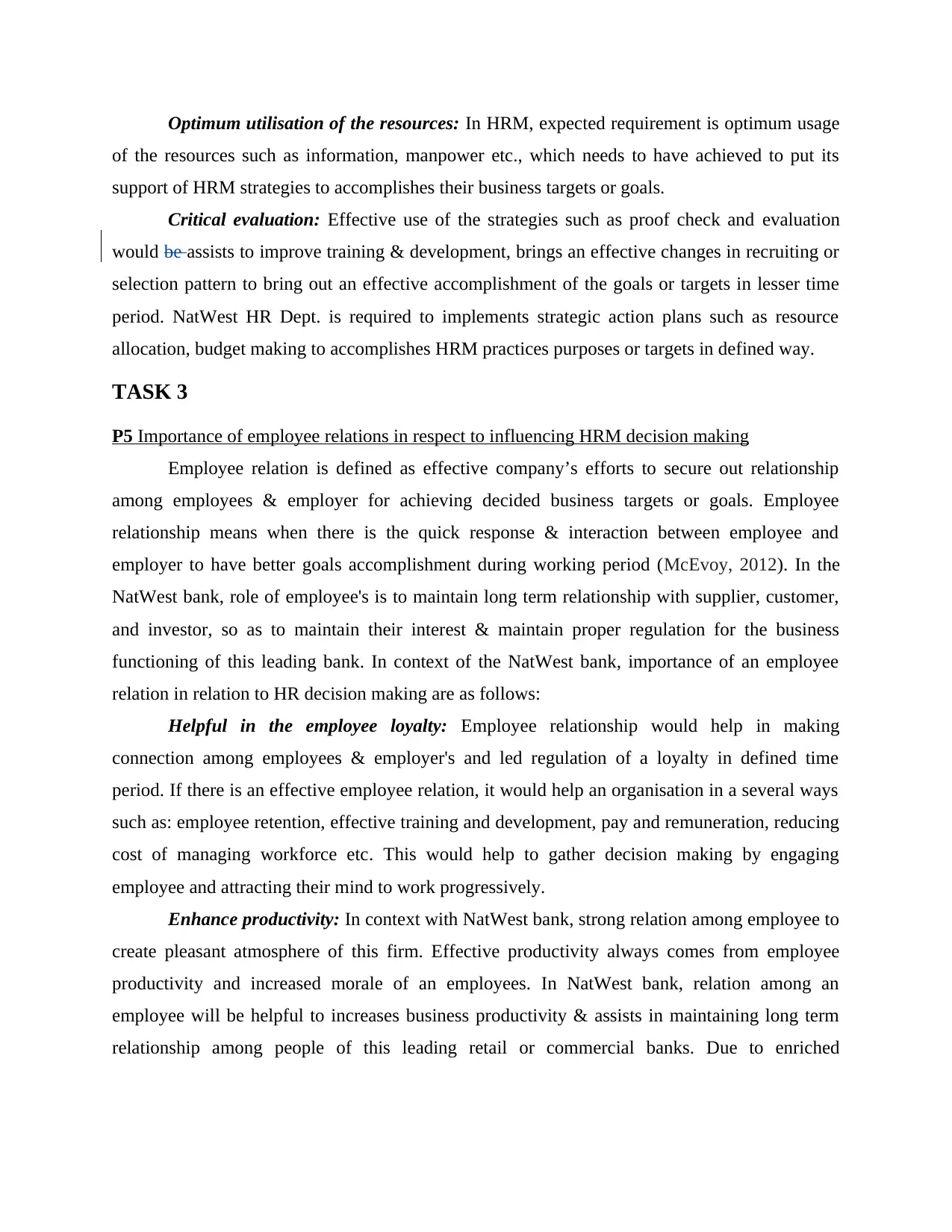
Optimum utilisation of the resources: In HRM, expected requirement is optimum usage
of the resources such as information, manpower etc., which needs to have achieved to put its
support of HRM strategies to accomplishes their business targets or goals.
Critical evaluation: Effective use of the strategies such as proof check and evaluation
would be assists to improve training & development, brings an effective changes in recruiting or
selection pattern to bring out an effective accomplishment of the goals or targets in lesser time
period. NatWest HR Dept. is required to implements strategic action plans such as resource
allocation, budget making to accomplishes HRM practices purposes or targets in defined way.
TASK 3
P5 Importance of employee relations in respect to influencing HRM decision making
Employee relation is defined as effective company’s efforts to secure out relationship
among employees & employer for achieving decided business targets or goals. Employee
relationship means when there is the quick response & interaction between employee and
employer to have better goals accomplishment during working period (McEvoy, 2012). In the
NatWest bank, role of employee's is to maintain long term relationship with supplier, customer,
and investor, so as to maintain their interest & maintain proper regulation for the business
functioning of this leading bank. In context of the NatWest bank, importance of an employee
relation in relation to HR decision making are as follows:
Helpful in the employee loyalty: Employee relationship would help in making
connection among employees & employer's and led regulation of a loyalty in defined time
period. If there is an effective employee relation, it would help an organisation in a several ways
such as: employee retention, effective training and development, pay and remuneration, reducing
cost of managing workforce etc. This would help to gather decision making by engaging
employee and attracting their mind to work progressively.
Enhance productivity: In context with NatWest bank, strong relation among employee to
create pleasant atmosphere of this firm. Effective productivity always comes from employee
productivity and increased morale of an employees. In NatWest bank, relation among an
employee will be helpful to increases business productivity & assists in maintaining long term
relationship among people of this leading retail or commercial banks. Due to enriched
of the resources such as information, manpower etc., which needs to have achieved to put its
support of HRM strategies to accomplishes their business targets or goals.
Critical evaluation: Effective use of the strategies such as proof check and evaluation
would be assists to improve training & development, brings an effective changes in recruiting or
selection pattern to bring out an effective accomplishment of the goals or targets in lesser time
period. NatWest HR Dept. is required to implements strategic action plans such as resource
allocation, budget making to accomplishes HRM practices purposes or targets in defined way.
TASK 3
P5 Importance of employee relations in respect to influencing HRM decision making
Employee relation is defined as effective company’s efforts to secure out relationship
among employees & employer for achieving decided business targets or goals. Employee
relationship means when there is the quick response & interaction between employee and
employer to have better goals accomplishment during working period (McEvoy, 2012). In the
NatWest bank, role of employee's is to maintain long term relationship with supplier, customer,
and investor, so as to maintain their interest & maintain proper regulation for the business
functioning of this leading bank. In context of the NatWest bank, importance of an employee
relation in relation to HR decision making are as follows:
Helpful in the employee loyalty: Employee relationship would help in making
connection among employees & employer's and led regulation of a loyalty in defined time
period. If there is an effective employee relation, it would help an organisation in a several ways
such as: employee retention, effective training and development, pay and remuneration, reducing
cost of managing workforce etc. This would help to gather decision making by engaging
employee and attracting their mind to work progressively.
Enhance productivity: In context with NatWest bank, strong relation among employee to
create pleasant atmosphere of this firm. Effective productivity always comes from employee
productivity and increased morale of an employees. In NatWest bank, relation among an
employee will be helpful to increases business productivity & assists in maintaining long term
relationship among people of this leading retail or commercial banks. Due to enriched
Paraphrase This Document
Need a fresh take? Get an instant paraphrase of this document with our AI Paraphraser
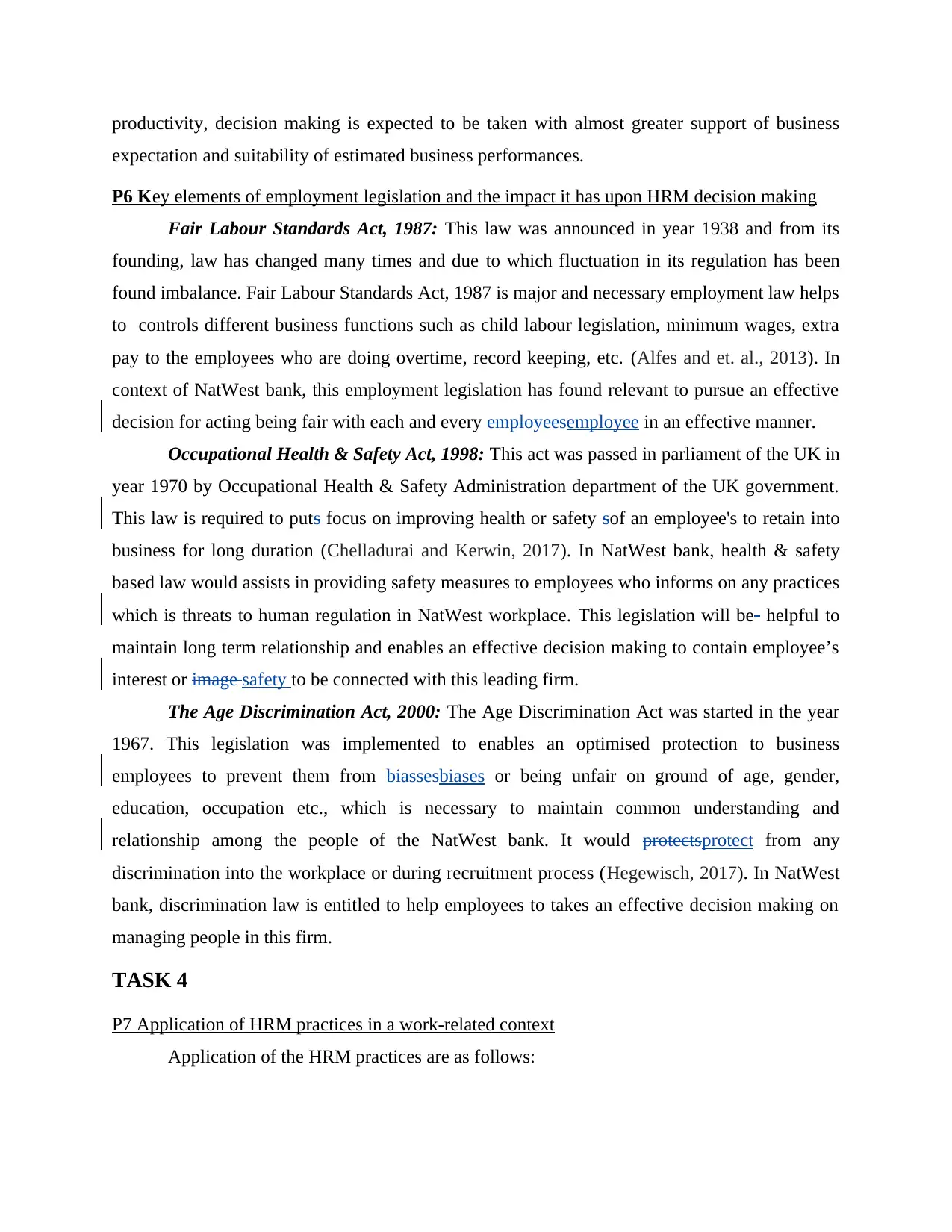
productivity, decision making is expected to be taken with almost greater support of business
expectation and suitability of estimated business performances.
P6 Key elements of employment legislation and the impact it has upon HRM decision making
Fair Labour Standards Act, 1987: This law was announced in year 1938 and from its
founding, law has changed many times and due to which fluctuation in its regulation has been
found imbalance. Fair Labour Standards Act, 1987 is major and necessary employment law helps
to controls different business functions such as child labour legislation, minimum wages, extra
pay to the employees who are doing overtime, record keeping, etc. (Alfes and et. al., 2013). In
context of NatWest bank, this employment legislation has found relevant to pursue an effective
decision for acting being fair with each and every employeesemployee in an effective manner.
Occupational Health & Safety Act, 1998: This act was passed in parliament of the UK in
year 1970 by Occupational Health & Safety Administration department of the UK government.
This law is required to puts focus on improving health or safety sof an employee's to retain into
business for long duration (Chelladurai and Kerwin, 2017). In NatWest bank, health & safety
based law would assists in providing safety measures to employees who informs on any practices
which is threats to human regulation in NatWest workplace. This legislation will be helpful to
maintain long term relationship and enables an effective decision making to contain employee’s
interest or image safety to be connected with this leading firm.
The Age Discrimination Act, 2000: The Age Discrimination Act was started in the year
1967. This legislation was implemented to enables an optimised protection to business
employees to prevent them from biassesbiases or being unfair on ground of age, gender,
education, occupation etc., which is necessary to maintain common understanding and
relationship among the people of the NatWest bank. It would protectsprotect from any
discrimination into the workplace or during recruitment process (Hegewisch, 2017). In NatWest
bank, discrimination law is entitled to help employees to takes an effective decision making on
managing people in this firm.
TASK 4
P7 Application of HRM practices in a work-related context
Application of the HRM practices are as follows:
expectation and suitability of estimated business performances.
P6 Key elements of employment legislation and the impact it has upon HRM decision making
Fair Labour Standards Act, 1987: This law was announced in year 1938 and from its
founding, law has changed many times and due to which fluctuation in its regulation has been
found imbalance. Fair Labour Standards Act, 1987 is major and necessary employment law helps
to controls different business functions such as child labour legislation, minimum wages, extra
pay to the employees who are doing overtime, record keeping, etc. (Alfes and et. al., 2013). In
context of NatWest bank, this employment legislation has found relevant to pursue an effective
decision for acting being fair with each and every employeesemployee in an effective manner.
Occupational Health & Safety Act, 1998: This act was passed in parliament of the UK in
year 1970 by Occupational Health & Safety Administration department of the UK government.
This law is required to puts focus on improving health or safety sof an employee's to retain into
business for long duration (Chelladurai and Kerwin, 2017). In NatWest bank, health & safety
based law would assists in providing safety measures to employees who informs on any practices
which is threats to human regulation in NatWest workplace. This legislation will be helpful to
maintain long term relationship and enables an effective decision making to contain employee’s
interest or image safety to be connected with this leading firm.
The Age Discrimination Act, 2000: The Age Discrimination Act was started in the year
1967. This legislation was implemented to enables an optimised protection to business
employees to prevent them from biassesbiases or being unfair on ground of age, gender,
education, occupation etc., which is necessary to maintain common understanding and
relationship among the people of the NatWest bank. It would protectsprotect from any
discrimination into the workplace or during recruitment process (Hegewisch, 2017). In NatWest
bank, discrimination law is entitled to help employees to takes an effective decision making on
managing people in this firm.
TASK 4
P7 Application of HRM practices in a work-related context
Application of the HRM practices are as follows:
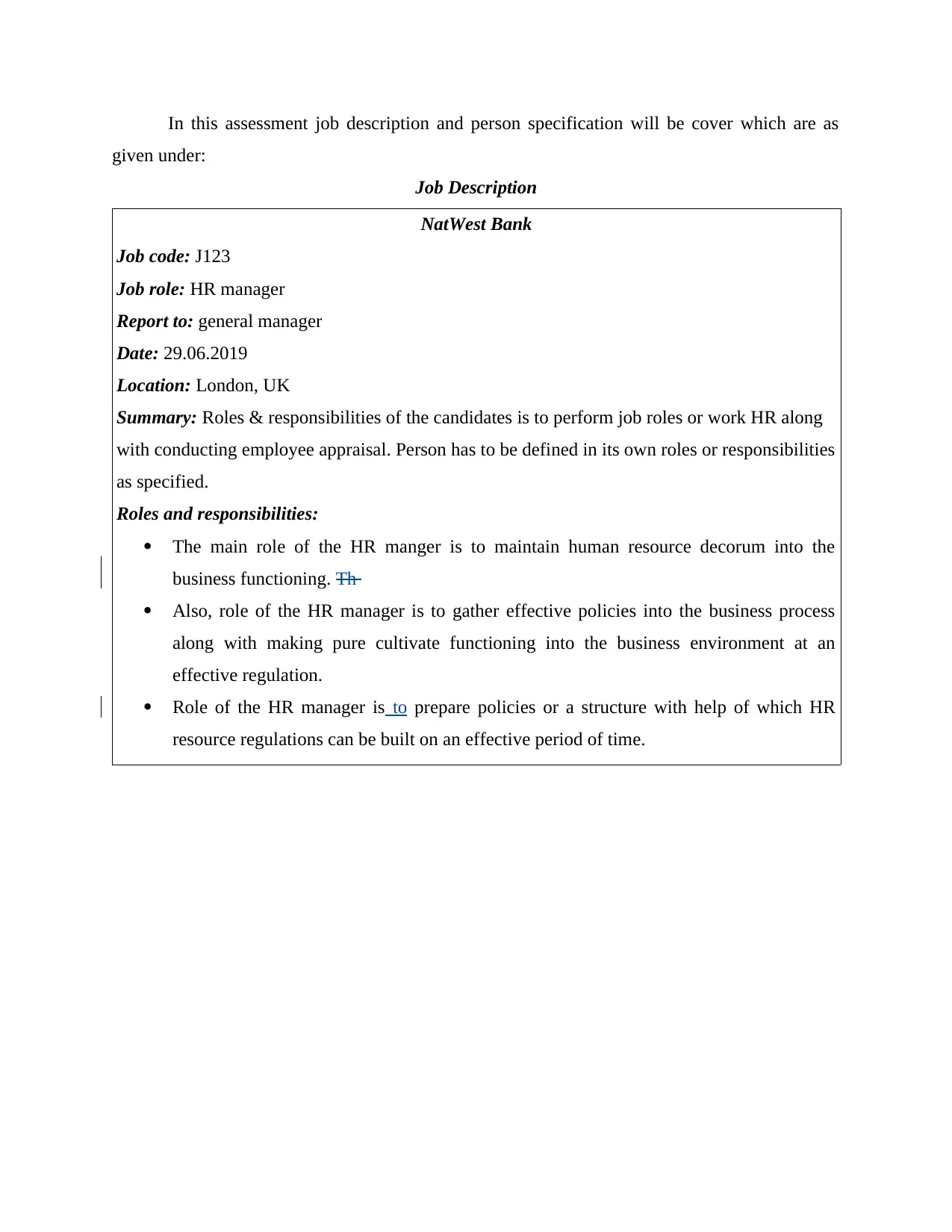
In this assessment job description and person specification will be cover which are as
given under:
Job Description
NatWest Bank
Job code: J123
Job role: HR manager
Report to: general manager
Date: 29.06.2019
Location: London, UK
Summary: Roles & responsibilities of the candidates is to perform job roles or work HR along
with conducting employee appraisal. Person has to be defined in its own roles or responsibilities
as specified.
Roles and responsibilities:
The main role of the HR manger is to maintain human resource decorum into the
business functioning. Th
Also, role of the HR manager is to gather effective policies into the business process
along with making pure cultivate functioning into the business environment at an
effective regulation.
Role of the HR manager is to prepare policies or a structure with help of which HR
resource regulations can be built on an effective period of time.
given under:
Job Description
NatWest Bank
Job code: J123
Job role: HR manager
Report to: general manager
Date: 29.06.2019
Location: London, UK
Summary: Roles & responsibilities of the candidates is to perform job roles or work HR along
with conducting employee appraisal. Person has to be defined in its own roles or responsibilities
as specified.
Roles and responsibilities:
The main role of the HR manger is to maintain human resource decorum into the
business functioning. Th
Also, role of the HR manager is to gather effective policies into the business process
along with making pure cultivate functioning into the business environment at an
effective regulation.
Role of the HR manager is to prepare policies or a structure with help of which HR
resource regulations can be built on an effective period of time.
⊘ This is a preview!⊘
Do you want full access?
Subscribe today to unlock all pages.

Trusted by 1+ million students worldwide
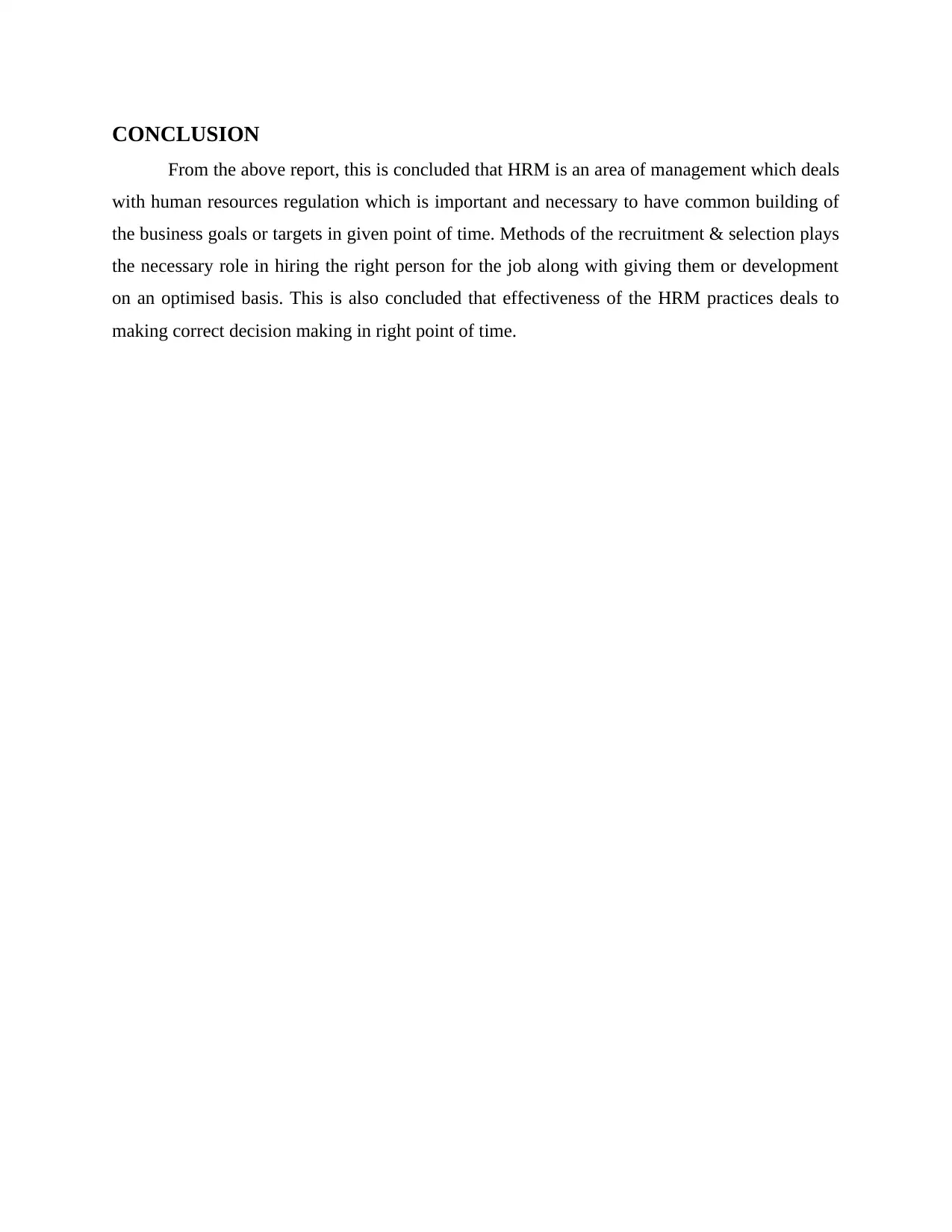
CONCLUSION
From the above report, this is concluded that HRM is an area of management which deals
with human resources regulation which is important and necessary to have common building of
the business goals or targets in given point of time. Methods of the recruitment & selection plays
the necessary role in hiring the right person for the job along with giving them or development
on an optimised basis. This is also concluded that effectiveness of the HRM practices deals to
making correct decision making in right point of time.
From the above report, this is concluded that HRM is an area of management which deals
with human resources regulation which is important and necessary to have common building of
the business goals or targets in given point of time. Methods of the recruitment & selection plays
the necessary role in hiring the right person for the job along with giving them or development
on an optimised basis. This is also concluded that effectiveness of the HRM practices deals to
making correct decision making in right point of time.
Paraphrase This Document
Need a fresh take? Get an instant paraphrase of this document with our AI Paraphraser
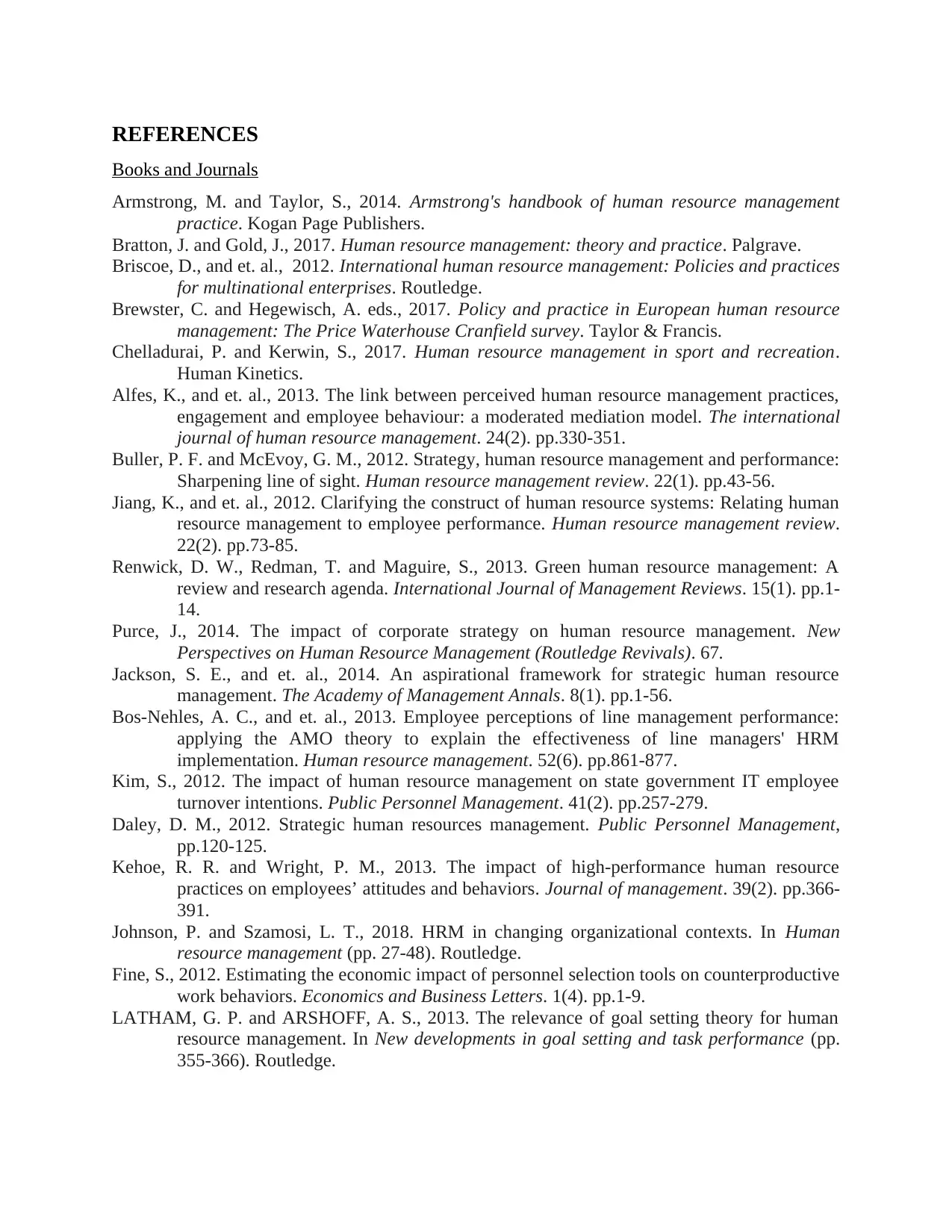
REFERENCES
Books and Journals
Armstrong, M. and Taylor, S., 2014. Armstrong's handbook of human resource management
practice. Kogan Page Publishers.
Bratton, J. and Gold, J., 2017. Human resource management: theory and practice. Palgrave.
Briscoe, D., and et. al., 2012. International human resource management: Policies and practices
for multinational enterprises. Routledge.
Brewster, C. and Hegewisch, A. eds., 2017. Policy and practice in European human resource
management: The Price Waterhouse Cranfield survey. Taylor & Francis.
Chelladurai, P. and Kerwin, S., 2017. Human resource management in sport and recreation.
Human Kinetics.
Alfes, K., and et. al., 2013. The link between perceived human resource management practices,
engagement and employee behaviour: a moderated mediation model. The international
journal of human resource management. 24(2). pp.330-351.
Buller, P. F. and McEvoy, G. M., 2012. Strategy, human resource management and performance:
Sharpening line of sight. Human resource management review. 22(1). pp.43-56.
Jiang, K., and et. al., 2012. Clarifying the construct of human resource systems: Relating human
resource management to employee performance. Human resource management review.
22(2). pp.73-85.
Renwick, D. W., Redman, T. and Maguire, S., 2013. Green human resource management: A
review and research agenda. International Journal of Management Reviews. 15(1). pp.1-
14.
Purce, J., 2014. The impact of corporate strategy on human resource management. New
Perspectives on Human Resource Management (Routledge Revivals). 67.
Jackson, S. E., and et. al., 2014. An aspirational framework for strategic human resource
management. The Academy of Management Annals. 8(1). pp.1-56.
Bos‐Nehles, A. C., and et. al., 2013. Employee perceptions of line management performance:
applying the AMO theory to explain the effectiveness of line managers' HRM
implementation. Human resource management. 52(6). pp.861-877.
Kim, S., 2012. The impact of human resource management on state government IT employee
turnover intentions. Public Personnel Management. 41(2). pp.257-279.
Daley, D. M., 2012. Strategic human resources management. Public Personnel Management,
pp.120-125.
Kehoe, R. R. and Wright, P. M., 2013. The impact of high-performance human resource
practices on employees’ attitudes and behaviors. Journal of management. 39(2). pp.366-
391.
Johnson, P. and Szamosi, L. T., 2018. HRM in changing organizational contexts. In Human
resource management (pp. 27-48). Routledge.
Fine, S., 2012. Estimating the economic impact of personnel selection tools on counterproductive
work behaviors. Economics and Business Letters. 1(4). pp.1-9.
LATHAM, G. P. and ARSHOFF, A. S., 2013. The relevance of goal setting theory for human
resource management. In New developments in goal setting and task performance (pp.
355-366). Routledge.
Books and Journals
Armstrong, M. and Taylor, S., 2014. Armstrong's handbook of human resource management
practice. Kogan Page Publishers.
Bratton, J. and Gold, J., 2017. Human resource management: theory and practice. Palgrave.
Briscoe, D., and et. al., 2012. International human resource management: Policies and practices
for multinational enterprises. Routledge.
Brewster, C. and Hegewisch, A. eds., 2017. Policy and practice in European human resource
management: The Price Waterhouse Cranfield survey. Taylor & Francis.
Chelladurai, P. and Kerwin, S., 2017. Human resource management in sport and recreation.
Human Kinetics.
Alfes, K., and et. al., 2013. The link between perceived human resource management practices,
engagement and employee behaviour: a moderated mediation model. The international
journal of human resource management. 24(2). pp.330-351.
Buller, P. F. and McEvoy, G. M., 2012. Strategy, human resource management and performance:
Sharpening line of sight. Human resource management review. 22(1). pp.43-56.
Jiang, K., and et. al., 2012. Clarifying the construct of human resource systems: Relating human
resource management to employee performance. Human resource management review.
22(2). pp.73-85.
Renwick, D. W., Redman, T. and Maguire, S., 2013. Green human resource management: A
review and research agenda. International Journal of Management Reviews. 15(1). pp.1-
14.
Purce, J., 2014. The impact of corporate strategy on human resource management. New
Perspectives on Human Resource Management (Routledge Revivals). 67.
Jackson, S. E., and et. al., 2014. An aspirational framework for strategic human resource
management. The Academy of Management Annals. 8(1). pp.1-56.
Bos‐Nehles, A. C., and et. al., 2013. Employee perceptions of line management performance:
applying the AMO theory to explain the effectiveness of line managers' HRM
implementation. Human resource management. 52(6). pp.861-877.
Kim, S., 2012. The impact of human resource management on state government IT employee
turnover intentions. Public Personnel Management. 41(2). pp.257-279.
Daley, D. M., 2012. Strategic human resources management. Public Personnel Management,
pp.120-125.
Kehoe, R. R. and Wright, P. M., 2013. The impact of high-performance human resource
practices on employees’ attitudes and behaviors. Journal of management. 39(2). pp.366-
391.
Johnson, P. and Szamosi, L. T., 2018. HRM in changing organizational contexts. In Human
resource management (pp. 27-48). Routledge.
Fine, S., 2012. Estimating the economic impact of personnel selection tools on counterproductive
work behaviors. Economics and Business Letters. 1(4). pp.1-9.
LATHAM, G. P. and ARSHOFF, A. S., 2013. The relevance of goal setting theory for human
resource management. In New developments in goal setting and task performance (pp.
355-366). Routledge.
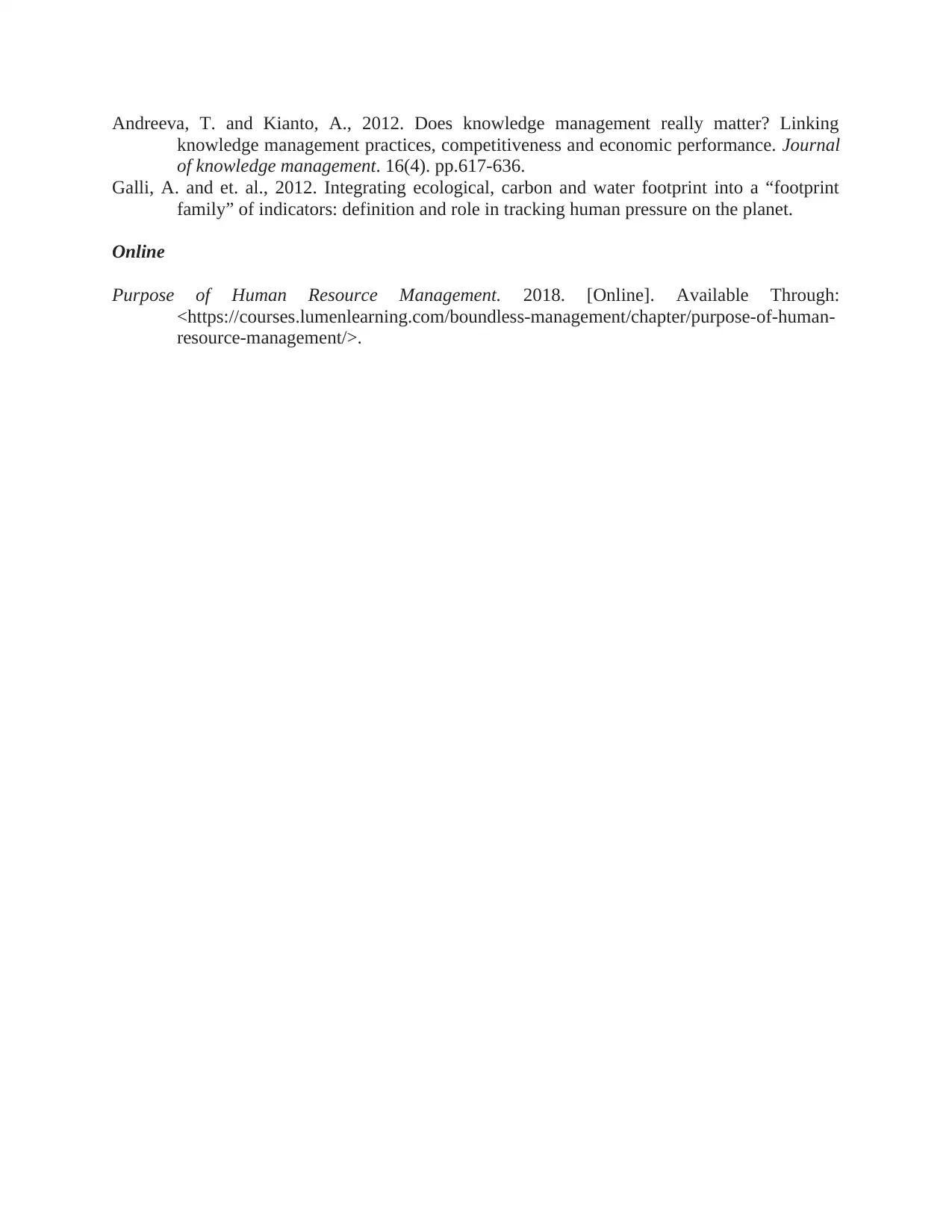
Andreeva, T. and Kianto, A., 2012. Does knowledge management really matter? Linking
knowledge management practices, competitiveness and economic performance. Journal
of knowledge management. 16(4). pp.617-636.
Galli, A. and et. al., 2012. Integrating ecological, carbon and water footprint into a “footprint
family” of indicators: definition and role in tracking human pressure on the planet.
Online
Purpose of Human Resource Management. 2018. [Online]. Available Through:
<https://courses.lumenlearning.com/boundless-management/chapter/purpose-of-human-
resource-management/>.
knowledge management practices, competitiveness and economic performance. Journal
of knowledge management. 16(4). pp.617-636.
Galli, A. and et. al., 2012. Integrating ecological, carbon and water footprint into a “footprint
family” of indicators: definition and role in tracking human pressure on the planet.
Online
Purpose of Human Resource Management. 2018. [Online]. Available Through:
<https://courses.lumenlearning.com/boundless-management/chapter/purpose-of-human-
resource-management/>.
⊘ This is a preview!⊘
Do you want full access?
Subscribe today to unlock all pages.

Trusted by 1+ million students worldwide
1 out of 12
Related Documents
Your All-in-One AI-Powered Toolkit for Academic Success.
+13062052269
info@desklib.com
Available 24*7 on WhatsApp / Email
![[object Object]](/_next/static/media/star-bottom.7253800d.svg)
Unlock your academic potential
Copyright © 2020–2025 A2Z Services. All Rights Reserved. Developed and managed by ZUCOL.


